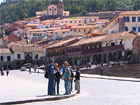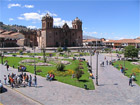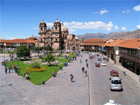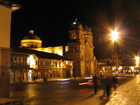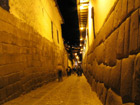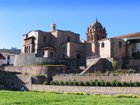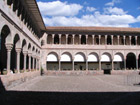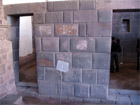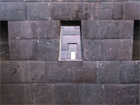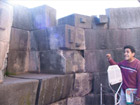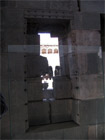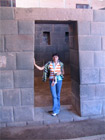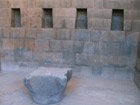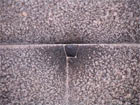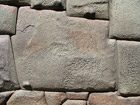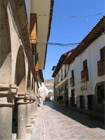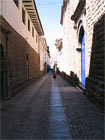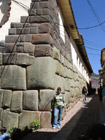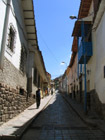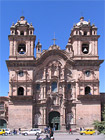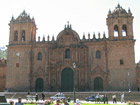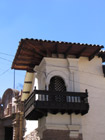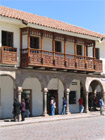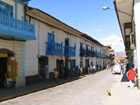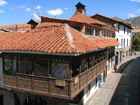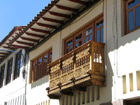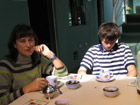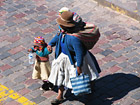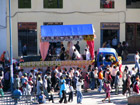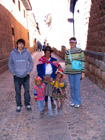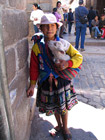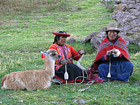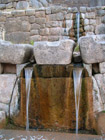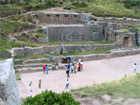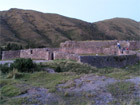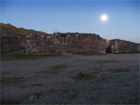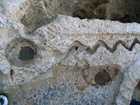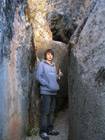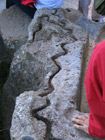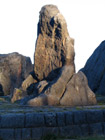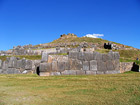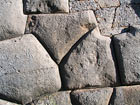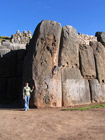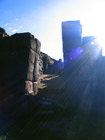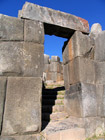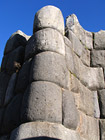 | |||
 | |||
| |||
|
|
|
Heart of the Inca's Empire
Cusco and its outskirts.
The ancestors of the Inca dynasty turned out in the area of Cusco approximately in 1200. There are at least two legends about advent of Incas. The most well known one narrates the story of Manco Capac and his sister-wife coming out of the immense waters of the Titicaca lake on the Peruvian-Bolivian highlands. This legend was recorded by a mestizo chronicles writer Garcilaso de la Vega. According to modern historians he has slightly transformed the ancient myth to the European taste. The second legend, which is less known to wide audience, according to a competent researcher Maria Rostworowski, is more closer to the Andean mythology. It tells about four Ayar brothers - Uchu, Manco, Cachi and Auca, who used to live in the cave on the mountain Tampu Tocco, close to the settlement of Pacaritambo (in the Quecha language, language of the Incas, - «the house of daybreak») which is 33 km away from Cusco. So the four Ayar brothers accompanied by their four sisters-wives came out of the cave Capac Toco in search of better land for living. Their travellings lasted for some years and it used to be interrupted by wars with local tribes, and quarrels between the brothers, so only one Ayar Manco finally reached the place, where Cusco was built. It was him, according to the legend, who became the forefather of the Incas dynasty having changed his name to Manco Capac. The Ayar brothers – heroes of myths. One can speak about historically real people starting only from Viracocha, father of the legendary Inca Pachacutec, with whom the previous history of Cuaco is connected. Pachacutec (at that time he was called Cusi Yupanqui) was one of the sons of Inca Viracocha, not the most favourable one, but already famous for his intellect and courage. In spite of this, after one of not very successful military campaign, Viracocha passe the reins of government to another son – Urco, and he himself retired to his palace not far from Cusco. Urco began enjoying all the benefits of his position with pleasure, having neglected the state affairs. Such behaviour of the new ruler aroused displeasure of military leaders, who would have preferred to see Cusi Yupanqui at that post. Political tension and social problems, caused by Urco's inability to rule, coincided with the decision of main Incas enemies – Chancas – to attack Cusco. At that time Incas were not yet so powerful and Chancas could fight against them. Urco was not ready to defend his people and together with his father and numerous family ran away from the enemy. And it was young Cusi Yupanqui, supported by the loyal to him military, rose to defend the capital. His position was difficult. Cusi Yupanqui asked for help from his neighbouring ally tribes, but those, aware of treason of Urco and Viracocha, did not dare to support the defenders of Cusco. So they had only to rely on their own strength. When Chancas rulers learned that only young prince remained in Cusco, they sent him a humiliating letter: they say, we give you three months to resume your strength, otherwise it is not worth fighting with you. However, when the invaders attacked Cusco, they unexpectedly met with a well organised repulse. But still the strength was unequal. When the defenders rows began to drastically dwindle, the chief priest of the Sun Topa Wanchire decided to dress the stones into a complete military uniform, so that, from the distance, the enemy could take them for real army and got frightened. And now, as the legend says, when Cusi Yupanqui let out a militant cry, the stones turned into real warriors and put the enemy to flight. Of course, one can believe in the legend where stones come alive, but most likely, the young prince opposed his military and organisational skills to a numerous enemy's army. After so glorious a victory, the authority of Cusi Yupanqui has grown even more, and he was given a name of Pachacutec (in the Quecha language - «the one who changes the world»). And now, apparently, Pachacutec was to become a Great Inca. But Viracocha by no means wanted to pass this title to him, moreover, together with Urco he conspired against the prince. And then, Pachacuted was forced to stand against his brother with weapon in hands. As a result, Urco was executed and Pachacutec, as he deserved, was named a new Great Inca. In this story all those features that made Cusi Yupanqui a great one, were revealed: unusual managerial abilities, rigidity and at the same time flexibility, while dealing with important issues, great ambitions and exact awareness of his goals and means how to achieve those. The period of rule of Pachacutec (1438 – 1471), his son Tupac Inca Yupanqui (1471 – 1493) and grandson Huayna Capac (1493-1527) became a golden era for the Empire. It is in this period that the country reached its maximum development both in the territorial and political-economical aspect. Pachacutec was called «the one that changes the world» not in vain: thanks to his innovations the Inca Empire became a great one. First of all he has expanded his territories having conquered his immediate neighbours. Inca's wisdom consisted in fact that he did not hurry to use weapons but rather tried to solve the issue by political ways, proposing one or another tribe to join the Empire in a peaceful manner. And very often such «bloodless» policy took effect. In case of active resistance the tribe chief was, naturally, executed and either «curaca» out of the Incas or the representative of other, loyal to the Incas tribe, which was more preferable, was appointed to his post. In case of peaceful solution, the tribe chief remained with all his benefits or was taken to Cusco, where he was trained, sometimes got married to one of the «daughters of the Sun», thus turning the former rival into a loyal ally-hostage. Despite the strict hierarchy in the Incas top, Pachacutec was the first one to introduce the concept «Inca by privilege» - any person who faithfully served the Empire could become one of those. Pachacutec used three basic principles to rule his ever growing territory. First he established a divaricate road network, maintained in ideal condition, which also included bridges and «tambos» - camps with enormous storage of food, weapon, clothes and where the travellers could have rest and food. And sometimes they had to cover 240 km per day. Another important factor – the Quechua language was introduced in all the conquered territories as the official one, however, the native language of the tribe was not cancelled. In the same manner Incas treated the religion: worshiping of the Sun was obligatory on the whole territory of the Empire, but the local cults were also allowed. And the most important – strict administrative system that controlled all spheres of life and ruled from the center. These measures helped to solve the three most important problems: geographic, language and organisational. The new capital was to correspond to these new tasks. So, Pachacutec started transformation of Cusco. The city was considerably expanded. In order to solve the problem of redistribution of water an extensive network of canals was established. Numerous stores for foodstuff, new temples and residential houses were constructed. Cusco became one of the biggest cities of the antiquity. Translated from Quechua Cusco means «the hub of the universe». It is from there – central square of the city – the Empire was divided into the four regions by imaginary lines and from here all roads emerged. Rephrasing the famous saying, we can say without exaggeration that all roads of the Inca Empire led to Cusco.
And the heart of the city and the basic creation of Pachacutec was Inticancha - temple of the Sun. Pachacutec turned the small, built by his predecessors modest temple, into a monumental, awe-inspiring structure. Conquistadors used to tell that all the temple walls were covered with golden plates and enchased with precious stones. That is why the temple was also called Koricancha, which means «storage of gold» in Quechua. Main idols from all the conquered provinces were also kept in the temple – and that had the double meaning. On the one hand it was a token of respect to that religion and from the other hand – idols acted as hostages in case one or another tribe displayed disobedience to Incas.
They say (reliable sources of information are sometimes difficult to find in Peru) that even in the 20th century they did not know that the ancient temple was partially preserved. And when one of the powerful earthquakes shook the country, Coricancha not only withstood but «threw down» excessive layers of the colonial period, with which the builders of the Dominicana abbey tried to submerge the «barbarism».
Cusco is a very beautiful city.
Of course the city is completely tourist-industry-oriented, even the Indians, in native dresses and children with llamas and lambs, pose exclusively for money, and there are more tourists in the streets than local people, but it does not minimize the charm of Cusco.
Luckily, there remained rather many imperial structures in the immediate vicinity of the capital.
It happened in 1527. Huayna Capac was in Quito, when rumors about strange «aliens» that came to the territory of Tahuantinsuyo reached him, and soon the last Great Inca fell victim to either plague or measles, the epidemics of which wiped out millions of Indians, who were not immune to these diseases. The sudden death of the chief along with other factors, helped conquistadors in their easy victory over the «children of the Sun».
| |||||||||||||||||
|
